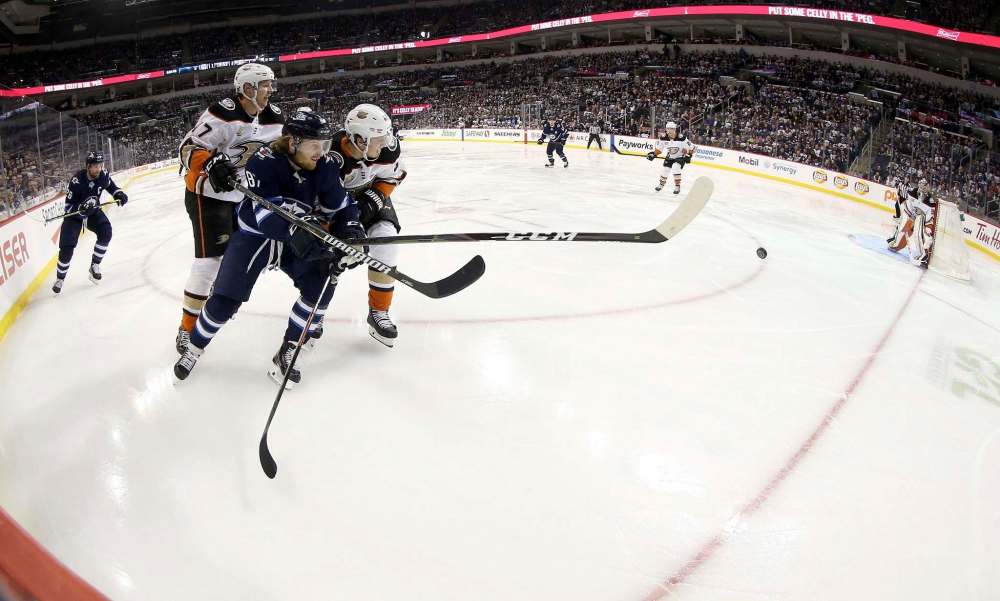Power-play efficiency key for defensively challenged Jets
Advertisement
Read this article for free:
or
Already have an account? Log in here »
To continue reading, please subscribe:
Monthly Digital Subscription
$19 $0 for the first 4 weeks*
- Enjoy unlimited reading on winnipegfreepress.com
- Read the E-Edition, our digital replica newspaper
- Access News Break, our award-winning app
- Play interactive puzzles
*No charge for 4 weeks then billed as $19 every four weeks (new subscribers and qualified returning subscribers only). Cancel anytime.
Read unlimited articles for free today:
or
Already have an account? Log in here »
Hey there, time traveller!
This article was published 15/01/2019 (1927 days ago), so information in it may no longer be current.
Recently I’ve written about the Winnipeg Jets struggling defensively in comparison to last season, where they were among the league’s elite shot-suppression teams. The good news for the Jets at even-strength, is that they aren’t in a situation where they’re about to see huge regressions in their shooting or save percentages.
What this means is, despite a bit of a dip on the defensive side, the way the Jets have played this season has given them almost the exact standings position that should be expected.
That’s great news for a Jets team that is currently on top of its division, with two games in hand on chief divisional rival Nashville Predators, so things are looking good.

Another positive note for the Jets is that they’ve managed to improve on last season’s deadly fifth-ranked power play, which was running along at 23.4 per cent, and this season is scoring on 28.1 per cent of its opportunities, the second-best mark in the NHL behind the Tampa Bay Lightning.
On average this season, teams are getting only 3.06 power plays per game which, as I’ve noted before, remains among the lowest recorded marks in history, so having a lethal power play isn’t as big of an advantage as it was in the ’80s and ’90s, when teams averaged more than 4.5 opportunities per game.
However, putting the fear of taking penalties into opponents’ heads can open things up at even-strength, and the efficiency of the Jets’ power play has allowed the team to put its stamp on games that otherwise would have gone to overtime or ended in regulation losses.
So what is it that makes the power play tick? Well, that’s the weird thing, when I looked into the Jets’ numbers the results were not what I expected, at all.
!function(e,t,s,i){var n=”InfogramEmbeds”,o=e.getElementsByTagName(“script”)[0],d=/^http:/.test(e.location)?”http:”:”https:”;if(/^/{2}/.test(i)&&(i=d+i),window[n]&&window[n].initialized)window[n].process&&window[n].process();else if(!e.getElementById(s)){var r=e.createElement(“script”);r.async=1,r.id=s,r.src=i,o.parentNode.insertBefore(r,o)}}(document,0,”infogram-async”,”https://e.infogram.com/js/dist/embed-loader-min.js”);
The Jets, one of the league’s most effective passing teams at five-on-five, complete passes to the slot at about the league average rate on the power play, while earning fewer than average high-danger chances.
Also surprising is that the Jets’ complete fewer east-west passes than the average team does with the man advantage, which is surprising, given Patrik Laine’s tendency to hang out in the left circle just outside the slot waiting for one-time opportunities.
Even if we narrow down east-west passes to only those completed by forwards to rule out point-to-point passes by defencemen, the Jets still rank at the league average.
Looking at scoring chances, the Jets are an above-average team at generating chances overall, and putting those chances on net, on the edge of the top-10 in the league, but that doesn’t go very far to explain their dominance on the power play, especially when you look at the percentage of shots that they’re taking from the slot.
!function(e,t,s,i){var n=”InfogramEmbeds”,o=e.getElementsByTagName(“script”)[0],d=/^http:/.test(e.location)?”http:”:”https:”;if(/^/{2}/.test(i)&&(i=d+i),window[n]&&window[n].initialized)window[n].process&&window[n].process();else if(!e.getElementById(s)){var r=e.createElement(“script”);r.async=1,r.id=s,r.src=i,o.parentNode.insertBefore(r,o)}}(document,0,”infogram-async”,”https://e.infogram.com/js/dist/embed-loader-min.js”);
Only 53.2 per cent of the Jets’ shot attempts on the power play come from the slot, which is only 18th-best in the NHL, so it becomes difficult to make a lot of sense out of what’s going on here.
There are some key factors that don’t show up in the data though. For example, the Jets have two players who are among the best in the entire NHL in scoring from further out in Patrik Laine and Mark Scheifele. Both players are bona fide snipers, no matter where they are on the ice, and it’s not a surprise that the two of them have scored 18 of the Jets’ 38 power play goals this season. Other factors are shot volume and shot quality, things that the data can miss.
Is it possible that the Jets’ scoring chances are more dangerous, on average, than other teams’ scoring chances? Certainly, and we can take some limited steps to quantify that.
Looking at the number of cycle chances that the Jets’ generate puts their passing into the slot in context. While they are close to league average at passing the puck there, they convert a disproportionate number of those passes into shots and, in fact, 83.2 per cent of their power-play scoring chances are preceded by cycle passes, while the average team is at 80.8 per cent.
On rebounds, the Jets are just average, but they generate more chances off the rush and forecheck than the average team as well, meaning a disproportionate number of their chances are preceded by passes, turnovers or zone entries, all of which make the chances more dangerous.
When you add it all up, I’m not sure if it amounts to a power play clicking at better than 28 per cent going forward, but it does look better than the numbers do on the surface.

Andrew Berkshire
Andrew Berkshire is a hockey writer specializing in data-driven analysis of the game.








